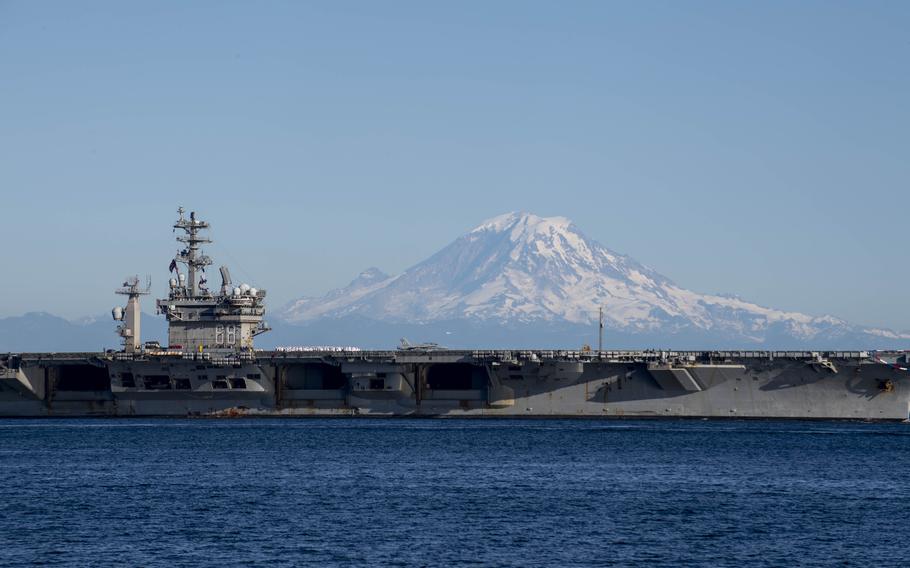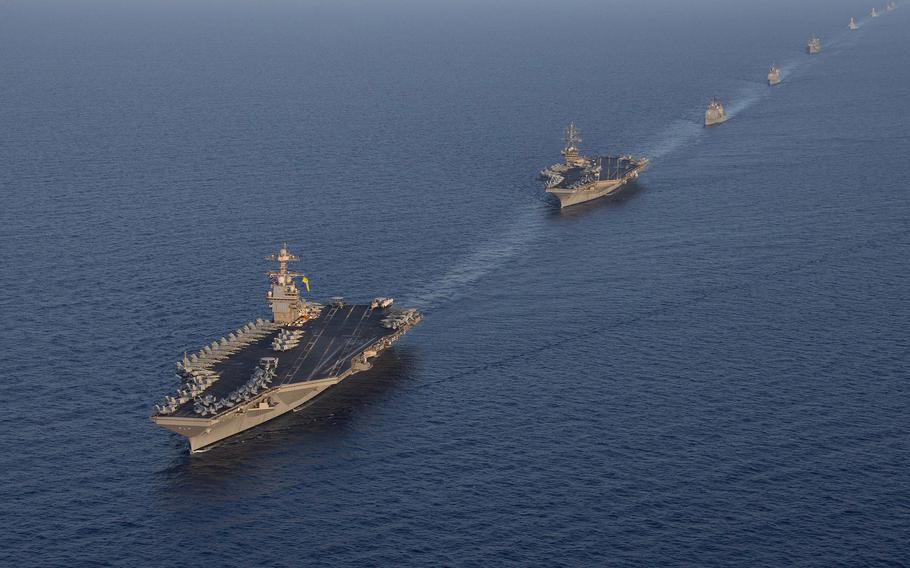
The aircraft carrier USS Nimitz (CVN 68) transits the Puget Sound on the way to its homeport of Bremerton, Wash., July 2, 2023. (Heather C. Wamsley/U.S. Navy)
The USS Nimitz has been the template of American sea power for nearly a half-century.
Commissioned four days after the fall of Saigon ended the Vietnam War in 1975, the 100,000-ton supercarrier powered by two Westinghouse A4W nuclear reactors could set off at 30 knots to trouble spots around the world and catapult 80 attack jets at enemies.
“You don’t have to ask anyone’s permission to use their bases or provide fuel for your ship — you just go and stay for as long as you need,” said Mark Cancian, a retired Marine colonel who is now a senior adviser with the Center for Strategic and International Studies in Washington, D.C.
The Navy would add nine more Nimitz-class carriers to the fleet over the next 34 years. When the Nimitz-class carrier USS George H.W. Bush was commissioned in 2009, the Navy simultaneously retired its last non-nuclear carrier, USS Kitty Hawk.
USS Nimitz is in Puget Sound Naval Shipyard for several months of maintenance before it starts what’s likely its final assignment: retirement. It will be followed in regular intervals by its older sister ships.
“Inactivation of Nimitz class aircraft carriers is currently scheduled to begin with USS Nimitz in 2026, subject to Congressional budget approval,” said Alan Baribeau, a spokesman for the Office of Corporate Communications at Naval Sea Systems Command.
While the Nimitz may disappear from the fleet, the idea it came to represent — the nuclear-powered aircraft carrier strike force — will live on.

Aircraft carriers USS Gerald R. Ford and USS Dwight D. Eisenhower sail with other U.S. and allied ships sail in the Mediterranean Sea on Nov. 3, 2023. (Jacob Mattingly/U.S. Navy)
The first ship of a new supercarrier class, USS Gerald R. Ford, is in the eastern Mediterranean as a sign of American support for Israel following the attack by Hamas militants from Gaza.
The Chief of Naval Operations Navigation Plan — the sea service’s public playbook — says a carrier accompanied by guided missile cruisers, anti-aircraft destroyers and attack submarines is America’s top option for quick response to hot spots from the Red Sea to the Strait of Taiwan.
“Nuclear-powered aircraft carriers, which will remain the most survivable and versatile airfields in the world, provide long-range, persistent sea control, power projection and organic sensing in contested seas, as well as flexible options across the spectrum of conflict,” the Navy’s recently released shipbuilding plan says.
The sentiment isn’t shared by all in the Pentagon and Congress.
Critics of the carriers’ dominance over official debate and dollars include advocates pushing for an increased focus on attack submarines, hypersonic missile boats and Unmanned Surface Vehicles — ships without any crew.
In the October 2023 issue of the U.S. Naval Institute Proceedings, retired Navy Vice Admiral David H. Lewis wrote that the Nimitz was a response to the world conflicts of 1975 — mainly the Soviet Union and its proxies worldwide.
“There was a clear adversary to beat,” Lewis wrote. “The challenges were less about technology and more about how many, when and where to allocate resources.”
Cancian says the debate over carriers splits naval strategists into two camps. To advocates, they are “90,000 tons of American sovereignty, deployable anywhere on the globe” while critics see them as soaking up too much of the defense budget for “increasingly vulnerable monuments to a naval age gone by.”
Carriers are at their best when they stack the odds heavily in favor of the side Americans are on — a role they have played in Iran, Iraq, Syria and the current conflict with Iranian-backed Houthi rebels firing missiles at shipping in the Red Sea.
“I don’t think the Houthi missiles can get past a carrier’s defenses,” Cancian said. “I’m not as sure about an attack by the Chinese.”
American ships and weapons are likely technologically superior overall to what the Chinese can bring to a battle, Cancian said. But the gap isn’t so great that the outcome of a swarm attack by Chinese missile boats and attack aircraft is assured.
According to a Reuters news agency report, China is in the midst of a major naval construction program, with 370 ships, up from 340 just over a year ago. China plans to have 435 ships by 2030.
The United States has 291 ships, but their total tonnage is twice the total of China’s Navy.
New weapons require new defensive measures or strategies. Underwater drones like those used by Ukraine against Russian ships in the Black Sea can be launched far from the target. Russia says it is developing hypersonic cruise missiles that can evade the ship’s anti-aircraft defenses.
The possibility of significant battle damage from could lead military commanders to restrict the exposure of a $14 billion Ford-class carrier with over 4,000 Americans aboard, Cancian said.
While Navy policy backs the continued construction and use of large aircraft carriers, alternatives are part of the future mix. Five American USVs — unmanned surface vehicles — took part in the Integrated Battle Problem (IBP) exercise to develop crewless ships that would operate alongside manned ships in the future.
A Navy modernization report called for a 2050 goal of having more than a quarter of the fleet consist of unmanned vessels.
The use of the supercarrier in the mid-21st century will be a question for after the Nimitz is gone. Its designation, “CVN-68,” stands for the 68th aircraft carrier commissioned by the Navy since the USS Langley was converted from a coal-carrying transport into CV-1 in 1920.
While the Navy has made no official announcement, the federal SAM.gov contracting website has solicited possible subcontractors to work on “CVN 68 Inactivation, Defueling Accomplishment” to be completed by 2030.